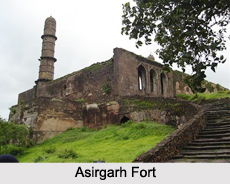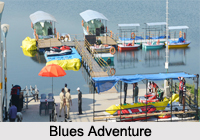 The Tapti River, also known as Tapi River is located in central India and runs following an east to west itinerary, between two rivers namely, the Godavari and Narmada. It journeys through Surat and is crossed by the Magdalla ONGC Bridge. Along this river there are several places of interest. There are major towns along the river, which are situated in the Indian states of Madhya Pradesh, Maharashtra and Gujarat. More specifically, these towns are Multai, Nepanagar and Burhanpur in Madhya Pradesh, Surat and Songadh in Gujarat and Bhusawal in Maharashtra.
The Tapti River, also known as Tapi River is located in central India and runs following an east to west itinerary, between two rivers namely, the Godavari and Narmada. It journeys through Surat and is crossed by the Magdalla ONGC Bridge. Along this river there are several places of interest. There are major towns along the river, which are situated in the Indian states of Madhya Pradesh, Maharashtra and Gujarat. More specifically, these towns are Multai, Nepanagar and Burhanpur in Madhya Pradesh, Surat and Songadh in Gujarat and Bhusawal in Maharashtra.
Multai
Multai is located on the northern bank of the river Tapti. It is one of the southern cities of Madhya Pradesh. More specifically, it can be defined as a small town and a Nagar Palika in the district of Betul. Multai covers almost half of the Satpura plateau. Sanskrit word for Multai is Multapi, which stands for origin of Tapti River. Multapi is known to be the initial name of the city, Multai. It was therefore named after the river Tapti. It has an average elevation of about 749 meters (2457 feet). Forests lie to the west of the city between the districts of East Nimar and Amaraoti. Multai was one of the regional headquarters connecting the district headquarter in the north to the district headquarter, Nagpur in Maharashtra, during the Maratha regime and British rule in India.
Multai is a holy place and a home to two temples namely, Prachin (old) Mandir and Naveen (new) Mandir. Both these temples are dedicated to Mata Tapti. According to Hindu mythology, Mata Tapti is known to be the daughter of Surya, the Sun God. Akhad Saptami Tapti Janmotsav is known to be celebrated in this town. The Multai town is bedecked and an annual mela is also held on this occasion. This town is known for many ancient Hindu Temples, where Lord Shiva and Hanuman are worshipped.
The city has people belonging to different religions and following different traditions and cultural practices. Bundelkhandi language and culture has been identified in the northern part of the town. The southern part of the town is known for the presence of Marathi Language and Maharastrian culture. The rest of the town is prominently occupied by tribal population, known as the Gonds and Korkus. They believe in Bada Mahadev. They are known to also believe in superstitions and animal sacrifice as a ritual is associated with them. They depend on natural herbs for healthcare and medication.
Burhanpur
Burhanpur is situated on the north bank of the Tapti River, on the southwestern border of Madhya Pradesh. More specifically, it is about 340 kilometers (211 mi) southwest of Bhopal and about 540 kilometers (336 mi) northeast of Mumbai. It can be defined as a mid-size city and an administrative seat of Burhanpur district. It has a municipal corporation and also is one of the district headquarters of the state of Madhya Pradesh.
 Burhanpur is well known for textile industries. It is the largest hub for power loom industry in Madhya Pradesh. Burhanpur has several places capable of attracting a plethora of tourists. Asirgarh Fort, Jama Masjid, Swami Narayan Temple, Ganesh Temple, Dargah-e-Hakimi and Shahi Qila are some of the places attracting the attention of tourists.
Burhanpur is well known for textile industries. It is the largest hub for power loom industry in Madhya Pradesh. Burhanpur has several places capable of attracting a plethora of tourists. Asirgarh Fort, Jama Masjid, Swami Narayan Temple, Ganesh Temple, Dargah-e-Hakimi and Shahi Qila are some of the places attracting the attention of tourists.
Nepanagar
Nepanagar is an industrial township located in Burhanpur district. More specifically, this small township lies between Burhanpur and Khandwa and has many small villages in its surrounding. The name of this town is partially derived form the word "NEPA", which stands for National Environment Protection Authority.
A noteworthy attraction of this small town is the newsprint paper mill called the Nepa Mills Limited (earlier known as The National News Print Ltd). The Nepa Mill is known to occupy total land area of about 1869 acres. There are about 2164 residential quarters in the township, belonging to the Nepa Mills.
Surat
Surat is the administrative capital of the Surat district. The city centre is located about 22 km (14 mi) south of the Tapti River. The city is located about 284 kilometers (176 mi) south of the state capital, Gandhinagar; about 265 kilometers (165 mi) south of Ahmedabad; and about 289 kilometers (180 mi) north of Mumbai. Surat was earlier known as Suryapur. It has an elevation of about 13 m (43 ft). Surat has a tropical savanna climate moderated strongly by the sea to the Gulf of Cambay. Surat is well known for its relaxed lifestyle and its cuisine.
Surat itself has various centers of attraction for its visitors. Bank of River Tapi has a place of interest called the Tapi River Front at Adajan. The Sardar Patel Museum is a home to a collection of over 10,000 specimens of arts and crafts. It was established in the year 1998 and was originally called the Winchester Museum. Heritage Square and Surat Castle or Surat Fort is known to be a historical castle. It was planned and built between 1540 and 1546 by Khudawand Khan. Presently, it is located in the Chowk Bazar area in Surat. It is one of the chief ancient monuments of Surat. Chintamani Jain Temple is located in the Shahpor area. It is known to be constructed in the 15th century. Noteworthy features of this temple are wooden carvings, extremely rare paintings of the Jain monk, Acharya Hemachandra and of the Solanki King, Kumarpal. Blues Adventures is a recreational and adventure project, inaugurated in January 2013 by the then Chief Minister of Gujarat, Mr. Narendra Modi. It is known for water-sports activities, amusement park and restaurants. It is located at the basin of River Tapti (Tapi) on the Singanpore side of Weir-cum-Causeway in Surat. Jagdishchandra Bose Aquarium, also known as Surat Aquarium, Gavier Lake, Dr. Shyama Prasad Mukharjee Surat Municipal Zoo or Sarthana Nature Park Science Centre, the Dutch Cemetery, Navinchandra Mafatlal Garden are some of the other places of attraction in Surat.
Songadh
Songadh is a municipal corporation in the district of Tapi. The main town of Fort Songadh is situated on Highway 6 with Nandurbar district to its east and Vyara (district headquarters) to its west. More specifically this town is located at the foot of a solitary hill. Son stands for Gold and Gadh stands for fort. Thus, Songadh means the `Fort of Gold`. This main town is divided into two other towns called Junagam (old town) and Navagam (new town). It has an average elevation of 112 meters (367 feet).
Ukai Dam, Swarnim Tapi Van, Parshuram Temple, Hindustan Bridge, Rokadiya Hanuman Temple, Gaumukh, Dosvada Dam-Rani Mahal, the Central Pulp Mills, quarries located around Songadh and the TPS and Hydro power station are the places of interest in Fort Songadh.
Bhusawal
Bhusawal or Bhusaval is a city and a municipal council, established in 1882 in Jalgaon district. More specifically, this city is situated on National Highway 6. It is considered to be the biggest taluka of Jalgaon district. It has an average elevation of 209 meters (685 feet).
Bhusawal is well known for the cultivation of banana. This place is frequented by traders from various parts of the country for the purpose of buying raw bananas. There is also international export of these bananas. Bhusawal is also well known for its special white brinjals. Cultivation of these brinjals takes place in the nearby areas. They are a part of the delicacies in local marriages, apart from daal baati toop (a lentil dish served with ghee) and peanut garlic chutney. Bhusawal is also popular in whole of Jalgaon district for two items namely, Banducha Vada-Pav and Ghasilal Vada-Pav. Excursions in Bhusawal can be organized to the Thermal Power Station of Maharashtra State Electricity Board (Deepnagar), Orient Cement Grinding Unit, Ordinance Factory (Bhusawal and Varangaon), Indian Oil Corporation Limited Depot and Railway`s Zonal Training School.
Related Articles:
Water Resources in India
Indian Rivers
Dams in India
Lakes of India
Estuaries of India















